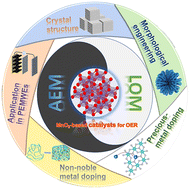Recent progress of manganese dioxide based electrocatalysts for the oxygen evolution reaction
Abstract
The oxygen evolution reaction (OER) represents an anodic reaction for a variety of sustainable energy conversion and storage technologies, such as hydrogen production, CO2 reduction, etc. To realize the large-scale implementation of these technologies, the sluggish kinetics of the OER resulting from multi-step proton/electron transfer and occurring at the gas–liquid–solid triple-phase boundary needs to be accelerated. Manganese oxide-based (MnOx) materials, especially MnO2, have become promising non-precious metal electrocatalysts for the OER under acidic conditions due to the good trade-off between catalytic activity and stability. This paper reviews the recent progress of MnO2-based materials to catalyze the OER through either the traditional adsorbent formation mechanism (AEM) or the emerging lattice-oxygen-mediated mechanism (LOM). Pure manganese dioxide OER catalysts with different crystalline structures and morphologies are summarized, while MnO2-based composite structures are also discussed, and the application of MnO2-based catalysts in PEMWEs is summarized. Critical challenges and future research directions are presented to hopefully help future research.
Keywords: Manganese dioxides; Electrocatalysts; Oxygen evolution reaction; Adsorbate evolution mechanism; Lattice-oxygen-mediated mechanism.

- This article is part of the themed collections: Virtual Collection—Electrocatalysis, Special Issue: Frontiers of Hydrogen Energy and Fuel Cells, Virtual Collections—ICM Reviews and Energy Frontiers: Electrochemistry and Electrochemical Engineering


 Please wait while we load your content...
Please wait while we load your content...